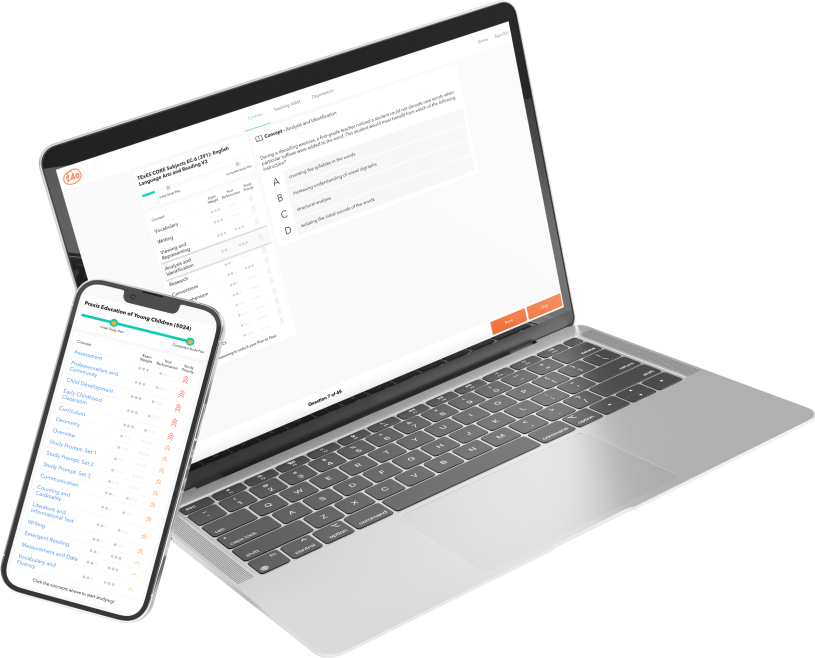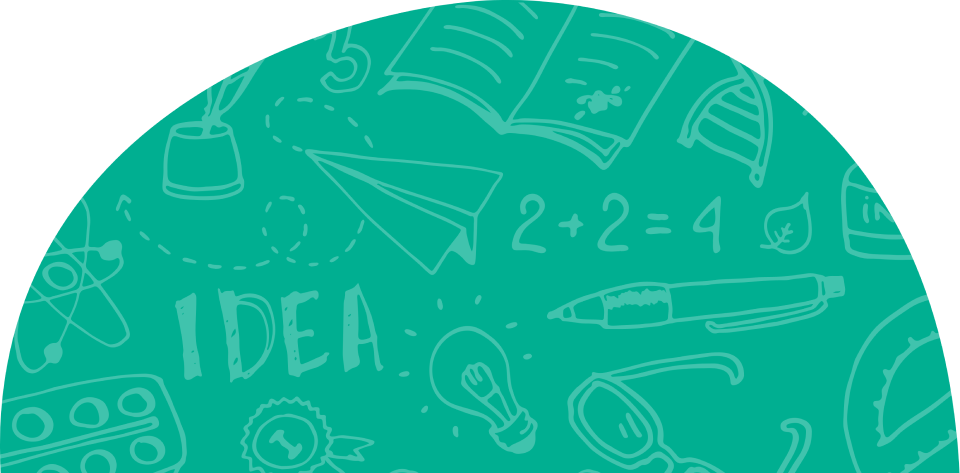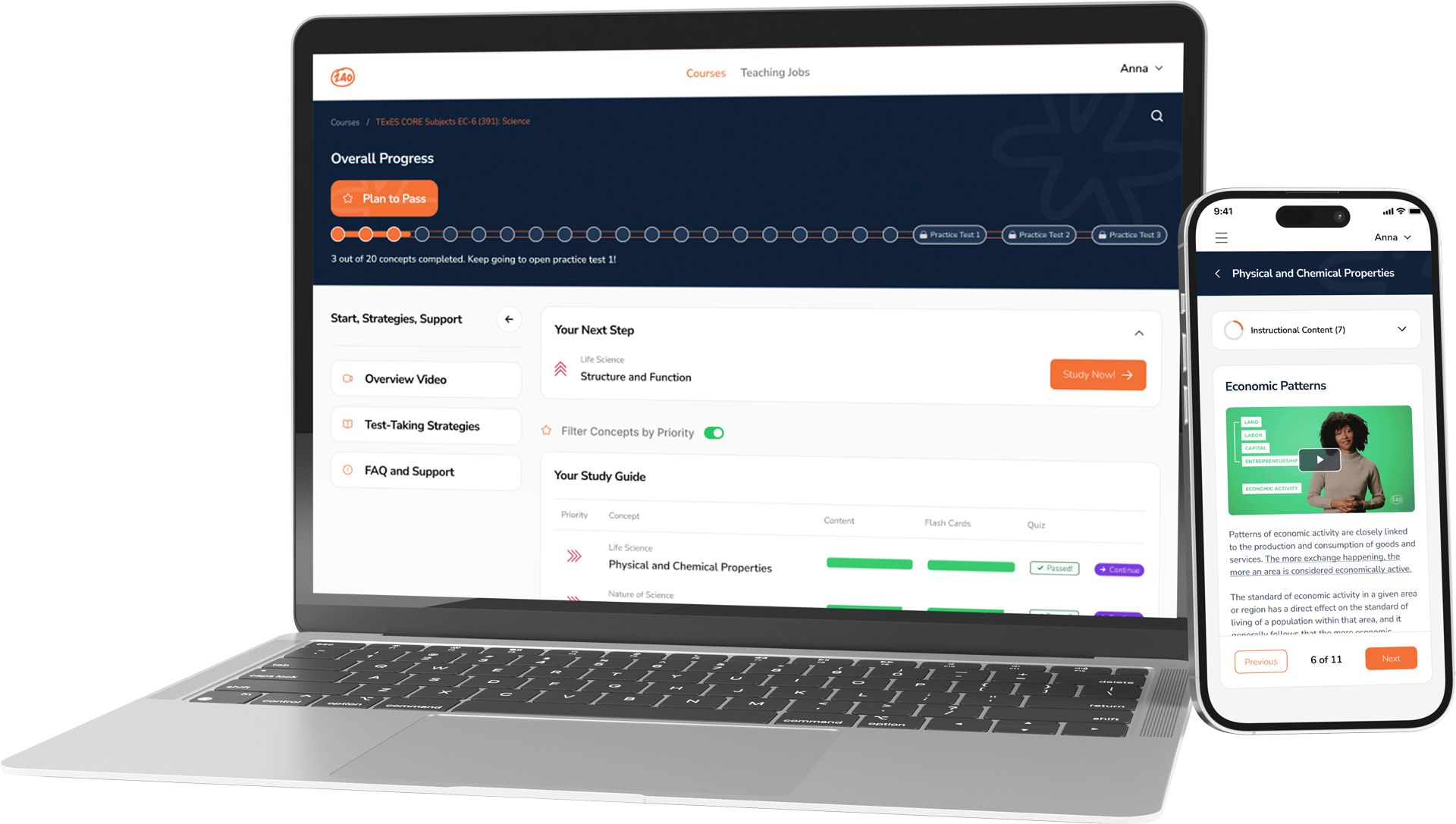MoGEA Test Information
MoGEA Test Information
The Missouri General Education Assessment (MoGEA) measures a test taker’s broad knowledge in these five areas: Reading, Writing, Math, Science, and Social Studies. In most cases, students entering a teacher preparation program in Missouri must take and pass the MoGEA.
You can take subtests individually, but you can only take the entire exam (all four subtests together) once. Any retakes (individual subtests) must be done after a 30-day waiting period.
MoGEA Test Format:
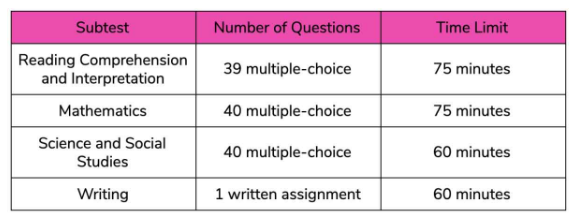
Cost: $59 for a single subtest.
Scoring: Examinees must pass all four subtests. Passing scores are set individually by each educator preparation program in Missouri. Here are just a few:
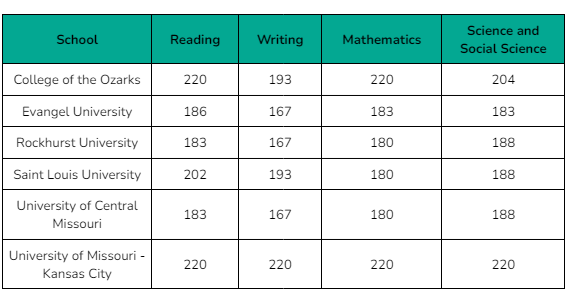
Study time:
To pass the MoGEA, there is no set time to study. It depends on the strengths and weaknesses of the participant in relation to the skills covered on the test.
The basic rule for assessments is to multiply the testing time by four, or by five if you feel you don’t have a handle on the material. For the MoGEA, prepare for 20 hours of studying, split up however it suits you.
Next, plan a course of study by focusing on your weaknesses. The best way is to review the 240 Tutoring materials.
What test-takers wish they’d known:
Test-takers tend to overestimate their abilities to perform well. Many students regret not putting more time and effort into preparing.
Fortunately, it’s easy to avoid this mistake by using MoGEA test prep materials.
When answering the multiple-choice questions, you should read all possible answers before marking the correct one. You don’t want to miss out on the best answer by not reading all of the responses!
Always check your answer before moving to the next question. Many test-takers are surprised by how they’re able to find overlooked errors in their work by using this strategy.
Information obtained from the Missouri Educator Gateway Assessments website: www.mo.nesinc.com
Welcome to our Missouri General Education Assessment (MoGEA) practice test and prep page. On this page, we outline the domains and key concepts for the Missouri General Education Assessment (MoGEA) exam. It is a free resource we provide so you can see how prepared you are to take the official exam.
While this free guide outlines the competencies and domains found on the exam, our paid Missouri General Education Assessment (MoGEA) study guide covers EVERY concept you need to know and is set up to ensure your success! Our online Missouri General Education Assessment (MoGEA) study guide provides test-aligned study material using interactive aids, videos, flash cards, quizzes and practice tests.
Will I pass using this free article? Will I pass using your paid study guide?
If you use this guide and research the key concepts on the Missouri General Education Assessment (MoGEA) exam on your own, it’s possible you will pass, but why take that chance? With our paid study guide, we guarantee you will pass.
→ Subscribe Now: MoGEA Complete Study Guide
Not ready to start studying yet? That’s OK. Keep reading, and when you’re ready take our free MoGEA practice tests.
- In this article, we will cover:
- MoGEA Test Information
- MoGEA Reading Comprehension and Interpretation
- MoGEA Mathematics
- MoGEA Science and Social Studies
- MoGEA Writing
MoGEA: Reading Comprehension and Interpretation
MoGEA Reading Comprehension and Interpretation Overview
You will have 75 minutes to answer 39 multiple-choice questions.
The Reading Comprehension and Interpretation subtest has 3 competencies:
- Literal Comprehension (33%)
- Inference and Interpretation (33%)
- Critical Reasoning and Evaluation (34%)
Literal Comprehension
This section tests your ability to identify the main idea of a text, decipher the meanings of words, figurative language, and connotative meanings, and choose the best summary or outline for a passage.
Let’s discuss some concepts that will more than likely appear on the test.
Main Idea
Finding a central idea or theme in a text is all about getting to the point. As you read, think about the “big picture” created by the details in the text in order to determine the author’s overall message. Is the author trying to make a general statement about life or allow you to understand a major concept?
You should be able to determine central ideas and themes, as well as describe how they develop throughout the course of the text. You must also analyze how details in the text support the main ideas and use details in the text to identify appropriate summaries.
Let’s take a moment to think about Aesop’s fable, “The Crow and the Pitcher.”
“A thirsty crow found a pitcher with a little water at the bottom. Unfortunately, the pitcher had a narrow neck and the crow couldn’t reach the water. However, the crow had an idea. He began dropping pebbles into the pitcher. With each pebble, the water rose higher. Eventually, the water rose high enough that the crow was able to drink.”
So, what central message about life is Aesop trying to get us to understand?
Aesop uses the details in the story to tell us that it is better to be determined and resourceful instead of accepting defeat. This overall message is the theme of “The Crow and the Pitcher.”
Connotative Meaning
A word may have both a connotative meaning and a denotative meaning. Connotation refers to the positive or negative associations that most words naturally have. Denotation is the precise, literal definition of a word.
The following chart shows three words that have the same denotation, but different connotations:

Authors often intentionally choose words with different connotations in order to affect the mood of the text or to show how they feel about a subject. How an author feels about a subject is his or her tone. Consider these statements:
“Dad probably will not buy that, because he is so cheap.”
“Dad probably will not buy that, because he is so frugal.”
Can you pick out the word with a negative connotation? If you said cheap, you’re right! Notice that the tone of the second sentence is much more pleasant.
Figurative Language
Literal language means exactly what it states. Figurative language, however, has a different meaning than what the words actually state. You know that if someone says, “I’m so hungry that I could eat a horse,” the person is using figurative language.
The person couldn’t, and hopefully wouldn’t, actually eat a horse. What the person means is that he or she is very hungry. While taking the Reading subtest, notice when figurative language is being used and determine what the author really means.
Inference and Interpretation
This section tests your ability to determine a writer’s opinion, tone, and purpose. You should be able to draw conclusions and to identify textual evidence upon which arguments are based. You will compare ideas in a text and how they relate to one another.
Here are some concepts that you may see on the test.
Writer’s Purpose
Simply put, the purpose of a piece of text is what the author hopes to achieve with his/her writing. It can be as simple as entertaining or informing an audience, or it can be to argue against a specific idea in order to persuade readers to act or think a certain way. An author can have more than one purpose for writing a passage.
Consider how an author writes about the topic to determine his or her purpose. For example, if the author’s purpose is to amuse the reader, the text might include jokes and use a silly or sarcastic tone.
How might this concept appear on the test? Take a look at this example:
For a long time, tofu was only found in specialty markets, but today tofu can be purchased in most supermarkets across the United States. It is made from the condensed milk of soybeans. Because it is high in protein, it is often used as a meat substitute by vegetarians.
Tofu also contains isoflavones, which may reduce the risk of cancer.
What is the author’s primary purpose?
A. The author writes to inform the reader about tofu. (correct) B. The author writes to persuade the reader to become vegetarian. C. The author writes to amuse the reader with a story about tofu. D. The author writes to persuade the reader not to eat tofu.
Making Inferences
While you complete the Reading subtest, you’ll use your inferencing skills to draw conclusions based on what the text states and what you already know. Remember, authors don’t always explain everything to us – sometimes they give us clues and let us figure out concepts and situations.
Consider this passage:
Jaylen was soaked by the time he got home, and he was disappointed to find that he missed out on a delicious dinner. The tempting smell of lasagna still lingered in the air, but the dishes were already clean. He pulled off his wet boots and began to think about what to eat.
You can make a ton of inferences from this passage. For example, the author doesn’t state that it has been raining, but you know this from the details in the text, such as the wet boots. You can also infer that Jaylen is hungry and that he doesn’t live alone – unless he lives in a magical house that cooks and does the dishes!
Point of View
Point of view refers to the perspective from which a text is narrated. As you work through the Reading subtest, sometimes you will be asked about the viewpoint or opinions of a narrator. When considering the viewpoint from which a passage is written, ask yourself what reasoning and evidence a speaker uses to support ideas.
Think about this passage:
Greenville gets really hot in the summer. On top of that, all of the rainfall means that there are mosquitos buzzing around everywhere and everyone’s yard is covered in puddles. In the fall, it’s so much cooler and drier.
Based on the passage, the writer’s point of view is that Greenville is less pleasant in the summer than in the fall. The writer uses the information about mosquitos and puddles as evidence to support this belief.
Critical Reasoning and Evaluation
This section tests your ability to evaluate a writer’s reasoning and determine if it is relevant and sufficient to support the ideas in a text. You’ll identify literary devices and the reason for their inclusion; you’ll look for examples of bias.
Here are some things you may see on the test.
Fact versus Opinion
Think back to when we discussed point of view. Sometimes, the authors give opinionated statements instead of “sticking to the facts.” As you complete the test, be mindful of which statements are factual and which are just opinions.
Remember, a fact can be proven true. An opinion is an expression of someone’s feelings, and it cannot be proven. Here’s an example of how this might appear on the test:
Humans have used the oils from plants for thousands of years. For example, Egyptians anointed their bodies with perfumed oils. We still use plant oils today, and essential oils are one type of plant-based oil that is used in cosmetic and health products.
Essential oils are removed from plants by steam distillation or mechanical expression. The chemicals which compose each essential oil give it its scent. Lavender oil contains linalool, and this chemical contributes to the oil’s unique aroma. The best-smelling essential oils are lemon essential oil, lime essential oil, and cypress essential oil.
Which of the following statements from the passage most clearly expresses an opinion?
A. “The best-smelling essential oils are lemon essential oil, lime essential oil, and cypress essential oil.” (correct)
B. “We still use plant oils today, and essential oils are one type of plant-based oil that is used in cosmetic and health products.”
C. “Humans have used the oils from plants for thousands of years.”
D. “Lavender oil contains linalool, and this chemical contributes to the oil’s unique aroma.”
Supporting Evidence
Whether including factual or opinionated statements, writers usually use evidence to support their points. On the test, you’ll use your experience as a reader to decide which evidence supports which point and whether or not the evidence is strong and reasonable.
For example, take a look at this passage:
I have a terrific mother, but my brother, Will, is very annoying. Last week, my mother bought me a pair of shoes as a surprise. It was really irritating when Will borrowed the shoes without asking me and got them dirty by wearing them to a baseball game.
So which evidence supports what in the passage? The writer uses the fact that his mother bought him shoes to support the idea that his mother is a terrific mother. The idea that Will is very annoying is supported by the evidence that Will borrowed the shoes without permission and was careless with them.
Literary Devices
Some literary devices to be familiar with before taking the Reading subtest include personification, similes, metaphors, irony, and foreshadowing. So, how might a literary device appear on the test? Let’s say that you see the statement:
That boy can run as fast as a cheetah.
Can you identify which literary devices are used in the statement?
Well, because the phrase includes extreme exaggeration, it is an example of hyperbole. The phrase is also an example of a simile, a comparison that uses “like” or “as.” The author uses these literary devices to let you know that the boy can run really fast!
And that’s some basic info about the MoGEA Reading Comprehension and Interpretation subtest.
MoGEA Mathematics
MoGEA Math Overview
You will have 75 minutes to answer 40 multiple-choice questions.
The Mathematics subtest has 3 competencies:
- Numbers and Algebra (50%)
- Measurement and Geometry (25%)
- Statistics and Data Analysis (25%)
Numbers and Algebra
This section tests your knowledge of rational numbers, linear equations, and inequalities. You’ll demonstrate your ability to divide fractions and use reasoning to solve real-world problems.
Let’s discuss some concepts that will more than likely appear on the test.
Dividing Fractions
First, we’ll review dividing fractions by whole numbers, then we’ll take a look at how to divide fractions by fractions.
When dividing a fraction by a whole number, multiply the bottom number (denominator) of the fraction by the whole number.
For example, let’s say that you need to divide ½ by 3:
½/ 3 = ?
You’ll multiply the whole number and the denominator:
1/(2 x 3)=1/6
Note that you may need to simplify your answer. For example,
4/12 might need to be simplified to ⅓.
Dividing Fractions by Fractions
When given a question that asks you to divide one fraction by another fraction, keep in mind that dividing fractions is just multiplying fractions by their reciprocals. Once your multiplication problem is set up, you will multiply your numerators then your denominators.
What might this look like on the test? Here’s an example:
(9/6)/ (2/4)
First, you’ll set up your multiplication problem:
(9/6)x (4/2)
And multiply to find your answer:
36/12 or 3
Linear Equations and Inequalities
These questions will evaluate your ability to interpret and solve inequalities and use linear equations. In order to be successful, you must apply arithmetic to algebraic expressions and use operations to generate equivalent expressions.
Here’s an example of the type of problem that you might find on the test:
Solve for x:
4x – 2 = 2x + 24
To solve this equation, you would bring like terms to one side:
4x – 2x = 2 + 24
Add and subtract on each side:
2x = 26
And divide each side by 2 to find the value of x:
x = 13
Geometric Sequences
In geometric sequences, the ratio between terms is always the same. That ratio is called the common ratio. For example, consider this sequence: 1, 2, 4, 8…
In this example, the common ratio is 2. Each consecutive number in the sequence is the previous number multiplied by 2. Try out this question:
What is the next term in the sequence ½, 2, 8…?
If you answered 32, you’re right! Each term in the sequence is multiplied by 4 in order to form the next term. Since 8 x 4 = 32, 32 is the next term.
Measurement and Geometry
This section tests your knowledge of geometrical figures, such as circles and triangles. You’ll use the Pythagorean theorem, as well as formulas for circumference and area to solve real-world problems.
Here is a concept that you may see on the test.
Pythagorean Theorem
Questions about the Pythagorean theorem will test your knowledge of right triangles and your ability to work with shapes to solve equations, make comparisons, and draw conclusions.
According to this theorem, side c is the side of the triangle opposite the right angle; side a and side b are the other two sides of the right triangle. You will use the Pythagorean equation (a²+ b²= c²), to solve related questions.
Here’s an example of what a related question might look like on the test:
Your friend cuts a sandwich into 2 right triangles. Your friend gives you half of the sandwich, so you now have 1 right triangle. Side a is 4 inches and side b is 5 inches. If side c is the hypotenuse, what is the length of side c?
To solve this problem, just plug the numbers into the Pythagorean equation:
(4²+ 5²= c²)
Apply the exponents:
(16 + 25 = c²)
Add the values on the left:
(41 = c²)
And find the square root of c:
(6.4 = c)
So, the hypotenuse of your half of the sandwich must be 6.4 inches!
Circumference
On the test, you’ll work with circles and calculate their circumferences and surface area.
To calculate the circumference of a circle, use the formula C = 2πr. The “r” represents the radius, a segment that connects the center of the circle to the edge of the circle.
How might this appear on the test?
You have a circular tub with a radius of 4 feet. What is the circumference of the tub?
A. 25.13 ft. (correct)
B. 50.27 ft.
C. 30.17 ft.
D. 21.22 ft.
In order to solve the given problem, just plug the value of the radius into the formula (C = 2πr) and multiply.
C = 2πr → C = 2π4 → C = 25.13 ft.
Area of a Triangle
The formula to find the area of a triangle is A =½hb.
In other words, the area is the height multiplied by the base then divided by 2. Wondering how this might look on the test? Consider this problem:
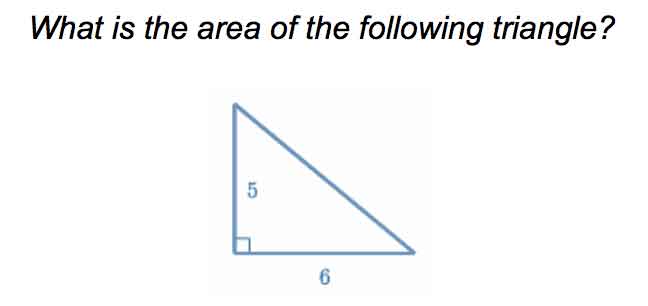
The area of a triangle is A =½hb, so the area of this triangle is A=½(6 x 5) or ½(30).
When you divide 30 in half, you get 15. The area of the triangle is 15 units².
The area of a triangle is A =½hb, so the area of this triangle is A= ½(6 x 5) or ½(30).
When you divide 30 in half, you get 15. The area of the triangle is 15 units².
Statistics and Data Analysis
In order to answer questions about statistics and data analysis, you’ll review charts and graphs. You’ll answer questions about central tendency based on the data you are given, and you’ll also use sample data to make inferences.
Here are concepts that you may see on the test.
Measures of Central Tendency
The Mathematics subtest will ask questions about measures of central tendency, such as mean, median, and mode. For example, take a look at the following question:
This list shows the price of cartons of orange juice in a store last year:
$3.50, $3.55, $4.00, $4.25, $4.75
This is the current list of prices for the juice:
$3.50, $3.55, $4.00, $4.25, $9.28
In the second list, which price is the outlier? Does the outlier change the mean, the median, or the mode?
In this example, the $9.25 price is the outlier, because it is drastically different from the other prices. The outlier does not affect the mode (frequency of appearance) of the prices. It also does not affect the median price because the number of prices remains the same on both lists. It does, however, affect the mean price.
The mean price of the juices in the first list is $4.01, and the mean price of juices in the second list is $4.90. You can find the mean of each list by adding the price of each carton and dividing the sum by the number of items in the list (5).
Sampling
While taking the Mathematics subtest, you will make inferences about populations by analyzing random samples. Take a look at this example question:
This year, 308 people have signed up for the library’s summer reading program. Each participant will receive a notebook with the library’s logo as a gift. A random sample of library patrons responded to a survey by selecting the color of notebook which they would each prefer.
Results:
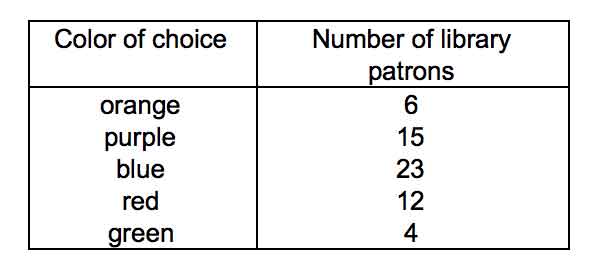
What is the most reasonable estimate for the number of this summer’s participants who will want a purple notebook?
You can estimate this number by multiplying the total population size (308) by the proportion of camp participants in the sample who would prefer a purple notebook.
Estimate = population size (308) × sample proportion
How can you find the sample proportion? Divide the number of sampled people who prefer purple by the total number of sampled people (15/60).
Estimate = 308 x (15/60)
After multiplying, your answer will be 77. This is the most reasonable estimate for the number of patrons who will want a purple notebook as a participation prize.
And that’s some basic info about the Mathematics subtest of the MoGEA exam.
MoGEA Science and Social Studies
Overview
You will have 60 minutes to answer 40 multiple-choice questions.
The Science and Social Studies subtest has 4 standards:
- Fundamental Scientific Concepts (25%)
- Science Inquiry and Literacy Skills (25%)
- Fundamental Social Studies Concepts (25%)
- Social Studies Inquiry and Literacy Skills (25%)
Fundamental Scientific Concepts
This section tests your knowledge on Earth science, physical sciences, and life sciences. You’ll answer questions related to life cycles, force, motion, and the water cycle.
Here are some concepts that you may see on the MoGEA test.
Life Cycles
A life cycle is a series of stages through which an organism passes during its lifetime. For example, a frog begins life as an egg and then transforms into a tadpole. Test out your knowledge with the following question:
Which of the following is the third stage of the butterfly life cycle?
A. Egg
B. Caterpillar
C. Butterfly
D. Chrysalis
The answer to the question is D, chrysalis. The stages of the butterfly life cycle in order are: egg, caterpillar, chrysalis, and butterfly.
Force and Motion
Without force, or if forces are perfectly balanced, an object will either stay still or continue to move at exactly the same speed. Unbalanced forces, however, cause changes in the speed of an object. This includes changing the speed of an object from completely stationary to moving.
Consider Newton’s Law: F = ma (net force is equivalent to the mass of an object multiplied by its acceleration):
A 1.13 kg ball rolls forward. What information do you need to determine the net force on the ball?
You would need to know the acceleration rate of the ball. Then, you could multiply the rate by 1.13 to determine the net force.
Water Cycle
The water cycle includes the processes by which water circulates among the Earth’s oceans, atmosphere, and land. It involves precipitation, drainage, evaporation, and transpiration.
What might this concept look like on the test? Consider the following question:
Water evaporates from the leaves of a sunflower plant. This is an example of the _____ component of the water cycle.
A. transpiration (correct)
B. precipitation
C. evaporation
D. drainage
As water leaves a plant and is released into the atmosphere, it transpires!
Science Inquiry and Literacy Skills
This section tests your knowledge of basic scientific theories and laws, the scientific method, and inquiry-based learning. You’ll evaluate scientific evidence to come to conclusions and provide evidence of understanding basic scientific terms.
Here are some concepts that you may see on the test.
Scientific Method
The Scientific Method includes the following steps:
Ask a question.
Conduct background research.
Form a hypothesis.
Design and perform an experiment,
Record and analyze data.
Conclude whether to accept or reject hypotheses.
Let’s say a researcher describes an educated guess she has about how a stimulus will affect an organism. Which step of the scientific method is she completing? She’s forming a hypothesis!
Inquiry-Based Learning
Inquiry-based learning allows students to learn via questions, problems, and scenarios. With inquiry-based learning, students aren’t just presented with facts. Take a look at this example question:
Mrs. Jones and her class are studying soybean plants. Mrs. Jones designs several activities for her students. Which of the following activities is the best example of inquiry-based learning?
A. Mrs. Jones asks each member of the class to form a hypothesis about how a seedling will respond when given milk instead of water (correct)
B. Mrs. Jones distributes worksheets which compare the life of soybeans to the life of cucumbers.
C. Mrs. Jones directs her class to a web page which includes a list of uses for soy.
D. Mrs. Jones asks her class to read and summarize a passage about growing crops.
Fundamental Social Studies Concepts
This section tests your knowledge of historical, geographical, economical, and cultural concepts. You’ll be asked questions about socialization, opportunity cost, and the way in which humans relate to their environment.
Here are some concepts that you may see on the test.
Human-Environment Interaction
There are three types of human-environment interactions.
The first type is how humans depend on the environment. Humans depend on the environment for shelter, food, and water.
The second type of human-environment interaction is how humans modify the environment. For example, humans can change the shape of the land in order to farm. The third type of human-environment interaction is the way humans adapt to the environment. For example, in cold climates, humans wear clothing to stay warm.
Which of the following options is an example of how humans modify the environment?
A. Humans build dams to prevent flooding. (correct)
B. Humans seek shelter when it rains.
C. Humans drink water to stay hydrated.
D. Humans eat fruit and vegetables to obtain fiber.
In the example question, the first option is correct. The second option gives an example of how humans adapt to the environment. The third and fourth options show ways in which humans depend on the environment.
Opportunity Cost
Opportunity cost is an important concept in economics. It relates to the basic relationship between scarcity and choice. When an individual or business makes a choice and gives up other options, the individual or business experiences an opportunity cost.
For example, imagine going to an ice cream store where each flavor costs the same amount of money per scoop. You usually choose a scoop of chocolate ice cream, but today you choose a scoop of vanilla ice cream.
So, what’s the opportunity cost? The vanilla ice cream does not cost you any extra money, but it does cost you the experience of eating the chocolate ice cream. Missing out on that experience is the opportunity cost. When asked to find the opportunity cost on the test, just look for what an individual or business loses when a choice is made.
Socialization
When individuals adapt to societal norms, they experience socialization. Socialization is important because it affects an individual’s ability to relate to other humans. Test your knowledge of this concept with the following question:
Which of the following options is NOT an example of socialization?
A. An individual chooses what to eat for dinner. (correct)
B. A parent teaches a child not to yell in public.
C. A traveler discovers that a gesture is considered impolite.
D. A new yoga student learns that it is not acceptable to speak during a session.
When looking for examples of socialization, look for how people modify their behaviors in social settings. Socialization is most commonly experienced by children and people who are in new social settings.
Social Studies Inquiry and Literacy Skills
This section will test your ability to ask relevant questions, conduct research, and evaluate sources. You will analyze content from multiple sources to find central ideas and determine whether any of the sources are biased.
Here are some concepts that you may see on the test.
Types of Bias
There are 9 types of bias in research. Bias occurs when humans intentionally or accidentally affect or misrepresent results. Let’s take a look at each type:
Acquiescence bias: This type of bias is also called friendliness bias. It occurs when a respondent has the tendency to agree with whatever he or she is presented with.
Social desirability bias: This bias occurs when a respondent reacts in a way that he or she thinks will lead to being liked.
Habituation: Respondents will sometimes provide the same answers to questions that are worded similarly. This is because people’s brains have a tendency to go on “autopilot.”
Sponsor bias: If a respondent knows or suspects the sponsor of the research, his or her feelings about the sponsor might affect his or her answers.
Confirmation bias: When a researcher forms a belief and uses the results of the research to confirm that belief instead of remaining objective, confirmation bias occurs.
Culture bias: An individual’s culture affects the way in which he or she perceives results, relationships, and situations.
Question-order bias: Survey questions can affect the way in which respondents answer subsequent questions. This is because the ideas presented in questions can impact an individual’s thoughts and feelings.
Wording bias: This type of bias occurs when a researcher elaborates on or summarizes a respondent’s answers. By doing this, the researcher puts the results of a study or survey in his or her own words instead of the respondent’s words. Therefore, the researcher is not accurately reporting results.
The Halo Effect: People have a tendency to see something or someone with a single positive attribute as completely positive. Both researchers and study participants can make this generalization and affect the results.
How might bias look in real life? Let’s say that a customer is asked about the service at a local restaurant. The customer might say that the service at the restaurant is excellent because the last time he went, he was very impressed by the waiter.
If the customer thinks more deeply about his response, however, he might realize that the service is usually average or even just below average. This is an example of the halo effect. The customer allowed one positive experience to affect his overall attitude towards the restaurant.
When reading texts on the test, be sure to watch out for bias. If you are reading a research study or an article, ask yourself whether human experiences and opinions have affected the “facts.”
Primary and Secondary Sources
You should be able to differentiate between primary and secondary sources and gather and analyze information from both. If you’ve forgotten the difference between these two types of sources, don’t worry – here’s a quick review:
Primary sources are first-hand accounts of a topic. Secondary sources are sources that are not primary sources. Try out the following question:
Which of the following sources is an example of a primary source?
A. Anne Frank’s diary
B. A non-fiction book about the Revolutionary War
C. A journal article about Native Americans during WWII
D. An ebook about famous works of art
If you chose the first option, you are correct! Anne Frank’s diary is a first-hand account of events. The other options are second-hand accounts of events and works.
Keep in mind that secondary sources can be based on primary sources or on other secondary sources. A book about Anne Frank’s diary would be a secondary source based on a primary source. A magazine review of that book would be a secondary source based on a secondary source.
And that is some basic information about the Science and Social Studies subtest of the MoGEA exam.
MoGEA Writing
You will have 60 minutes to complete 1 written assignment.
The Writing subtest has 1 competency.
Here are some things to keep in mind while completing the writing portion of the MoGEA.
During the test, you will write an essay of 400-600 words and no more than 1,000 words. Your essay will be given a score between 1 and 4, with 4 being the best score. You’ll need to score at least a 3 to show that you have a general command of writing skills.
Your score will be based on 5 general criteria:
- Appropriateness: the extent to which your essay addresses the assignment
- Focus and Unity: the inclusion of a topic sentence and the ability to stay on topic
- Organization: effective and reasonable use of sentences and paragraphs
- Development: the extent to which you support ideas
- Grammar and Conventions: the extent to which your essay uses correct grammar, spelling, and punctuation
While writing, you will support claims by using evidence and appropriate vocabulary. You will need to use correct grammar, punctuation, and spelling and form a variety of sentence structures. Be sure to maintain a clear focus when writing and to use an effective topic sentence and strong conclusion.
Remember to address counterarguments to your ideas in order to strengthen your argument. Try to finish your essay with at least 10 minutes left to edit and revise.
An that is some information about the MoGEA exam.

